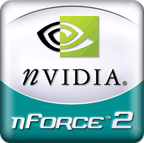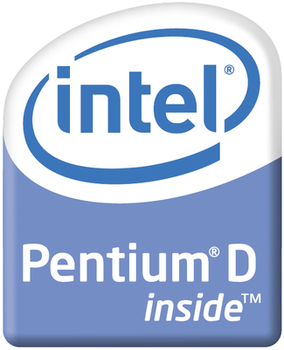HyperTransport (HT), formerly known as Lightning Data Transport, is a technology for interconnection of computer processors. It is a bidirectional serial/parallel high-bandwidth, low-latency point-to-point link that was introduced on April 2, 2001. The HyperTransport Consortium is in charge of promoting and developing HyperTransport technology.

In a computer system, a chipset is a set of electronic components on one or more integrated circuits that manages the data flow between the processor, memory and peripherals. The chipset is usually found on the motherboard of computers. Chipsets are usually designed to work with a specific family of microprocessors. Because it controls communications between the processor and external devices, the chipset plays a crucial role in determining system performance.

In computing, a northbridge is one of two chips comprising the core logic chipset architecture on motherboards for older personal computers. A northbridge is connected directly to a CPU via the front-side bus (FSB) to handle high-performance tasks, and is usually used in conjunction with a slower southbridge to manage communication between the CPU and other parts of the motherboard.

The southbridge is one of the two chips in the core logic chipset on older personal computer (PC) motherboards, the other being the northbridge. As of 2023, most personal computer devices no longer use a set of two chips, and instead have a single chip acting as the 'chipset', for example Intel's Z790 chipset.

The nForce2 chipset was released by Nvidia in July 2002 as a refresh to the original nForce product offering. The nForce2 chipset was a platform for motherboards supporting AMD's Socket A CPUs along with DDR SDRAM. There were multiple variations of the chipset including one with an integrated GeForce4 MX graphics processor (IGP), and one without.

The nForce4 is a motherboard chipset released by Nvidia in October 2004. The chipset supports AMD 64-bit processors and Intel Pentium 4 LGA 775 processors.

Pentium D is a range of desktop 64-bit x86-64 processors based on the NetBurst microarchitecture, which is the dual-core variant of the Pentium 4 manufactured by Intel. Each CPU comprised two cores. The brand's first processor, codenamed Smithfield and manufactured on the 90 nm process, was released on May 25, 2005, followed by the 65 nm Presler nine months later. The core implementation on the 90 nm "Smithfield" and later 65 nm "Presler" are designed differently but are functionally the same. The 90 nm "Smithfield" contains a single die, with two adjoined but functionally separate CPU cores cut from the same wafer. The later 65 nm "Presler" utilized a multi-chip module package, where two discrete dies each containing a single core reside on the CPU substrate. Neither the 90nm "Smithfield" nor the 65 nm "Presler" were capable of direct core to core communication, relying instead on the northbridge link to send information between the 2 cores.

The nForce3 chipset was created by Nvidia as a Media and Communications Processor. Specifically, it was designed for use with the Athlon 64 processor.

Rendition, Inc., was a maker of 3D computer graphics chipsets in the mid to late 1990s. They were known for products such as the Vérité 1000 and Vérité 2x00 and for being one of the first 3D chipset makers to directly work with Quake developer John Carmack to make a hardware-accelerated version of the game (vQuake). Rendition's major competitor at the time was 3Dfx. Their proprietary rendering APIs were Speedy3D and RRedline.
A memory controller is a digital circuit that manages the flow of data going to and from a computer's main memory. A memory controller can be a separate chip or integrated into another chip, such as being placed on the same die or as an integral part of a microprocessor; in the latter case, it is usually called an integrated memory controller (IMC). A memory controller is sometimes also called a memory chip controller (MCC) or a memory controller unit (MCU).

ALi Corporation is a major designer and manufacturer of embedded systems integrated circuits, and a former manufacturer of personal computer integrated circuits. It is based in Taiwan, and is a subsidiary of the Acer group.
The nForce 600 chipset was released in the first half of November 2006, coinciding with the GeForce 8 series launch on November 8, 2006. The nForce 600 supports Intel's LGA 775 socket and AMD's Quad FX platform and replaces the nForce 500 series.
The AMD 700 chipset series is a set of chipsets designed by ATI for AMD Phenom processors to be sold under the AMD brand. Several members were launched in the end of 2007 and the first half of 2008, others launched throughout the rest of 2008.
This is a comparison of chipsets designed by Nvidia. Nvidia stopped producing chipsets in 2009.

The HP Pavilion dv9000 was a model series of laptops manufactured by Hewlett-Packard Company that featured 16:10 17.0" diagonal displays.
Intel X99, codenamed "Wellsburg", is a Platform Controller Hub (PCH) designed and manufactured by Intel, targeted at the high-end desktop (HEDT) and enthusiast segments of the Intel product lineup. The X99 chipset supports both Intel Core i7 Extreme and Intel Xeon E5-16xx v3 and E5-26xx v3 processors, which belong to the Haswell-E and Haswell-EP variants of the Haswell microarchitecture, respectively. All supported processors use the LGA 2011-v3 socket.

On June 26, 2007, Dell released the new Inspiron desktop series, under the Dell Inspiron branding, as a replacement to the Dell Dimension desktop computers.










